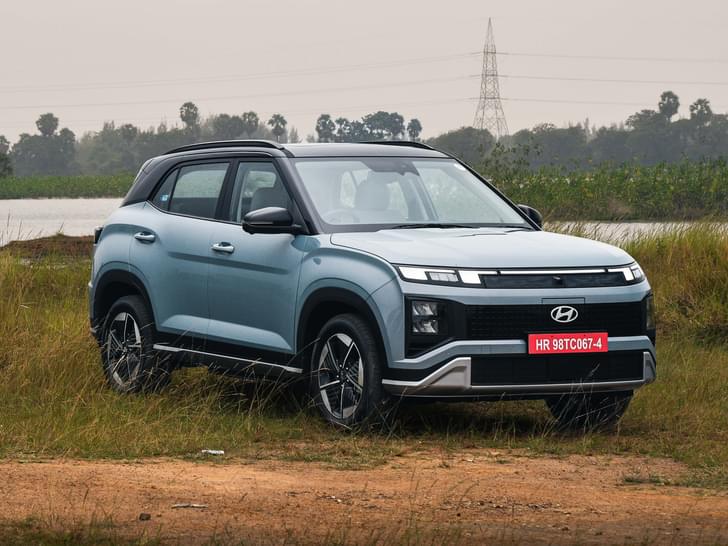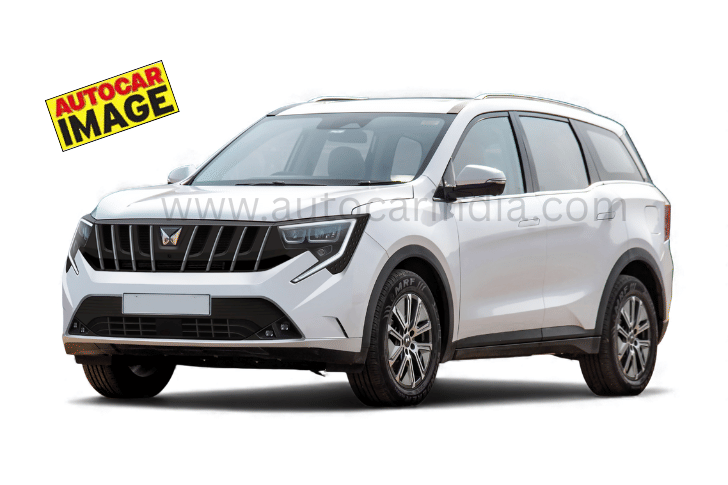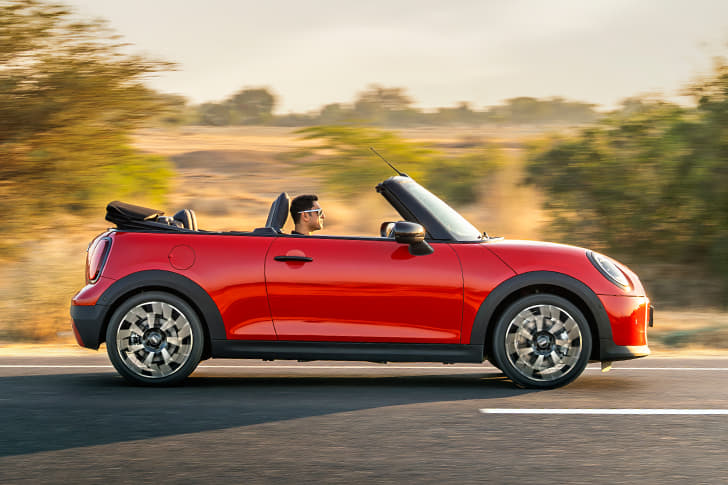
Last Updated on: 12 Nov 2025
Hyundai Verna
The Hyundai Verna is one of the oldest Hyundai nameplates in India, the first edition of which was launched back in 2006. Currently in its fourth generation avatar, the Verna is available in 14 trims, including Petrol EX MT, Petrol S MT, Petrol SX MT, Petrol S CVT, Petrol SX + MT, Petrol SX CVT, Petrol SX (O) MT, Turbo Petrol SX MT, Petrol SX + CVT, Turbo Petrol S (O) DCT, Turbo Petrol SX (O) MT, Turbo Petrol SX DCT, Petrol SX (O) CVT, Turbo Petrol SX (O) DCT.
In the city of Delhi, the on road prices start from ₹12.45 lakh for the base-spec Petrol EX MT trim. These prices go all the way up to ₹19.68 lakh, on-road. It rivals the Skoda Slavia, Volkswagen Virtus and Honda City in India.
Verna mileage range is 18.6 kmpl - 20.6 kmpl.
Key Highlights of Hyundai Verna
- It is available in 14 trims, including Petrol EX MT, Petrol S MT, Petrol SX MT, Petrol S CVT, Petrol SX + MT, Petrol SX CVT, Petrol SX (O) MT, Turbo Petrol SX MT, Petrol SX + CVT, Turbo Petrol S (O) DCT, Turbo Petrol SX (O) MT, Turbo Petrol SX DCT, Petrol SX (O) CVT, Turbo Petrol SX (O) DCT.
- Gets an option between a 115hp, 1.5-litre naturally aspirated petrol and a 160hp, 1.5-litre turbo-petrol engine.
- Both engine options are offered with a choice between manual and automatic transmission options.
- Naturally aspirated petrol variants feature a dual-tone off-whiter and black cabin theme, which, for the turbo-petrol trims, is finished in an all-black hue with red accents.
- Feature-loaded inside with amenities like a 10.25-inch touchscreen infotainment system, a sunroof, ventilated and heated front seats and a wireless phone charger.
- It was crash tested by Global NCAP in 2023, where it scored a 5-star safety rating for both adult and child occupants.
- Safety features include 6 airbags as standard, Level-2 ADAS, Front and rear parking sensors, rear parking camera and an electronic parking brake.
Hyundai Verna Latest Updates
08 Jan 2025: Hyundai Verna updated with new S CVT and S(O) DCT trims; S MT trim offers sunroof
04 Nov 2024: New Amazon Grey exterior colour added to the mix, rear spoiler offered as standard and prices hiked
03 Oct 2023: Verna scores 5-star Global NCAP crash safety rating
Hyundai Verna Features and specifications
Our Rating | 8 |
Mileage | 18.6 kmpl - 20.6 kmpl |
Engine | 1482 cc - 1497 cc |
Fuel Type | Petrol |
Transmission | Manual, CVT Auto, Dual-Clutch Auto |
Seats | 5 |
Body Style | Sedan |
Doors | 4 |
Max Power | 160hp at 5500 |
Max Torque | 253 Nm at 1500-3500 |
Warranty Distance | Unlimited km |
Warranty Duration | 3 Years |
Hyundai Verna price & variants
Hyundai Verna ex showroom prices start from ₹10.69 lakh for the entry-level Petrol EX MT trim. This goes up to ₹16.98 lakh for the fully-loaded Turbo Petrol SX (O) DCT trim. The Verna on road pricing is between ₹12.45 lakh and 19.68 lakh in the city of Delhi.
- The base-spec EX variant is available only with a manual transmission option.
- The one-over base S is the most affordable trim to get an automatic transmission option with the naturally aspirated petrol engine.
- The S(O) Turbo is the most affordable variant with the turbo-petrol engine and it is only available with the DCT option.
- The top-spec SX Turbo and SX(O) Turbo, on the other hand, are offered with both manual and automatic transmission choices.
Hyundai Verna expert review
We like
Turbo's strong performance
Smooth and refined
Long features list
We don't like
Unexciting to drive
No diesel or hybrid option
6
8
9
8
8
9
9
Reviewed by: Gavin D'Souza
Hyundai Verna reviews

Hyundai Verna comparison




Hyundai Verna mileage
The Hyundai Verna comes with two engine options, both offered with manual and automatic transmission choices, and has a claimed mileage range of 18.6 kmpl - 20.6 kmpl.
| Fuel type | Displacement | Transmission | Mileage |
|---|---|---|---|
| Petrol | 1497 cc | Manual | 18.6 kmpl |
| Petrol | 1497 cc | CVT Auto | 19.6 kmpl |
| Petrol | 1482 cc | Dual-Clutch Auto | 20.6 kmpl |
| Petrol | 1482 cc | Manual | 20 kmpl |
Hyundai Verna news
Hyundai Verna Images
Check out the Hyundai Verna images in the gallery, which highlight its sleek and futuristic body design and a feature-rich cabin with a lot of modern-day amenities.
The Verna brings together stylish looks, a comfortable and spacious cabin, a 5-star rated safety suite, along with two potent engine options for varied driving needs.
Hyundai Verna videos
Cars delivering 10 to 15 kmpl mileage achieve a balance between performance and practicality. Numerous petrol SUVs, sedans, and premium hatchbacks in India belong to this category. Vehicles in the 10-15 kmpl range appeal to urban buyers seeking comfort, advanced features, and reasonable fuel efficiency.


.jpg?w=640&q=75)
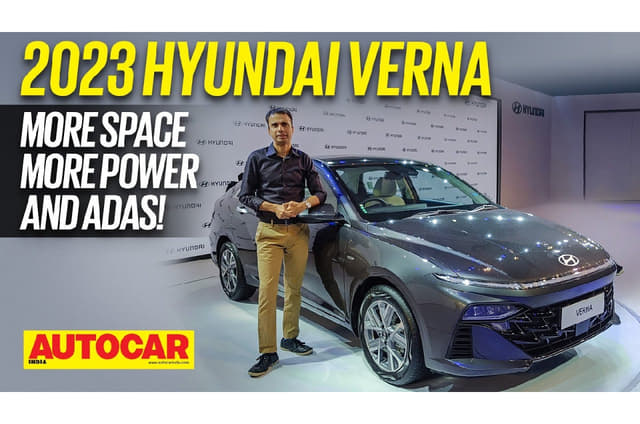
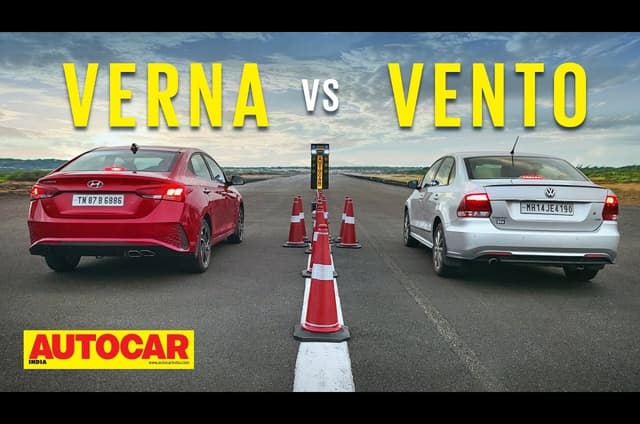

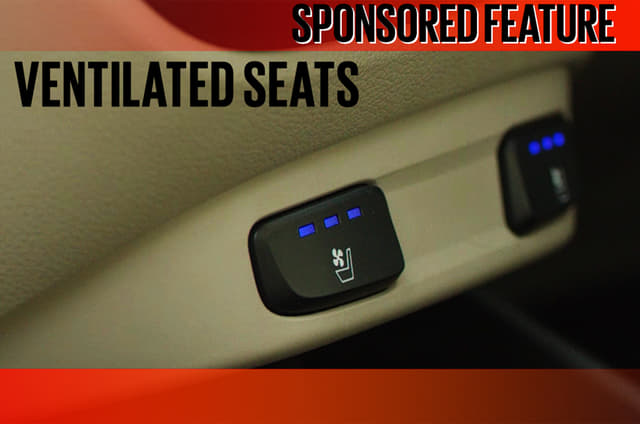


Hyundai Verna Colours
Hyundai Verna is available in 9, including Abyss Black, Amazon Grey, Atlas White, Atlas White Dual Tone, Fiery Red, Fiery Red Dual Tone, Starry Night, Tellurian Brown, Titan Grey. Among these, only the Atlas White hue is available with a dual-tone black roof, which is offered only with the turbo-petrol variants.
Inside, the Verna packs in a beige and black cabin theme for the naturally aspirated petrol variants, while the turbo-petrol variants get a sportier all-black hue with red accents for added contrast.
Hyundai Verna FAQs
Trending Questions on Hyundai Verna - Answered by Autocar Experts
I currently have two cars Hyundai Accent and Kia Carens Clavis DCT,now I want to upgrade my Accent to buy Verna Turbo Dct I am currently confused between Verna Turbo Dct,Venue Turbo Dct and Creta Turbo Dct , Kindly suggest me from above my running is nearly 1200 km on Highway and I like the design of the Verna kindly suggest me from the above cars listed which one should I Buy
I purchased a Verna Turbo SX(O) DCT automatic in December 2024. Will the cost of ownership be higher in the years to come, considering spare parts and service costs? What would be its resale value now? The car has done 5,600 km to date.
I am looking to buy a petrol automatic, preferably a sedan. My on-road budget is ₹20 lakh. What are my options?
Given your requirement and budget, you currently have four options. The Skoda Slavia and Volkswagen Virtus are mechanically identical, and they stand out for their punchy turbo petrol engine options and ride and handling balance.
The Honda City has a refined 1.5-litre naturally-aspirated petrol engine and has the best back seat. The Hyundai Verna, meanwhile, has the most features, and it can be had with either a turbo-petrol or a naturally-aspirated petrol engine.
The Slavia, Virtus and Verna have also received a full, 5-star safety rating from Global NCAP.
We are a family of two (newly married). I am confused between the i20 N Line N8 and the Verna 1.5 NA petrol manual. My budget is ₹16 lakh. Fuel preference is petrol manual. Brand preference is Hyundai, Kia, Honda, Volkswagen, and Skoda. My yearly usage is about 10,000-12,000 km, with 60% highway and 40% city driving. I am more concerned about mileage and want to know which of these two will be more fuel-efficient.
I need to buy my second car purely for driving pleasure. Budget is within ₹25 lakh, and I definitely want an ICE petrol vehicle. Sedan, SUV, or MUV, anything works. Please advise.
I want to upgrade my Swift ZXI. Which automatic car is the best option within a budget of ₹20 lakh?
There are plenty of options in your budget. If you want a sedan, your options include the Honda City, which comes with a CVT automatic. Other good options include the Hyundai Verna, Volkswagen Virtus, and Skoda Slavia, all offering two automatic gearbox choices.
Go for the City or the Verna with the CVT gearbox, as they’ll be more efficient than the others.
As for SUVs, you'll get most midsize SUVs in your budget. However, you can choose between the Hyundai Creta, Kia Seltos, or Maruti Suzuki Victoris; all three offer a good blend of a refined driving experience, features, and fuel efficiency.
After comparing various sedans, I have liked the Verna SX(O) DCT Turbo the best. I drive about 500 km a month and occasionally make road trips of around 400 km one way. Is this car a good choice?
While the Hyundai Verna DCT is good, the Skoda Slavia would be a better highway car. It is more stable, the engine and gearbox are smoother, and it is more spacious too.




































































































